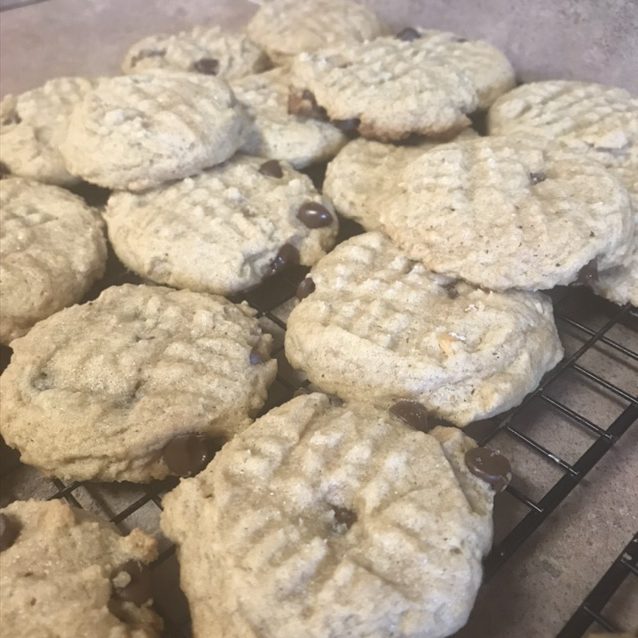I have always wanted to make a sourdough started. It’s a “someday” task that has remained on my list of perpetual projects for years. Even though Covid hasn’t changed my day to day significantly, I am finding myself leaning into those perpetual projects more. Chris and I did a very thorough cleaning/declutter at the end of last year, so that’s not top of our list. I have watched very little TV or movies, surprisingly – I think I know that it’s a slippery slope of binge watching days, which won’t fill my cup. So, I decided to tackle the sourdough starter.
It kind of started when I joined a baking collaboration on Instagram for bread! I’ve never done a bread baking collaboration, but I love bread. (Side note: I’m starting a petition that carbs don’t count during a pandemic – who’s in?) A couple of the members of the group were chatting about sourdough and someone shared a fantastic article from King Arthur flour on how to make your own sourdough starter. And thus, the journey began.
Meet Rona. Yes, you must name your sourdough starter. This is not a task taken on lightly. For the first week or two, you must attend to her twice daily. She takes a LOT of flour. She is temperamental about her temperature. And sometimes she likes to play hard to get. The basics are that you will use equal parts flour (starting with whole wheat) and water. You mix them together and let her sit for 24 hours.

On day 2, you measure out 113 grams of starter and feed her with equal parts of flour and water. At this point you switch to all-purpose flour. Make sure you have plenty of flour if you plan to start — each feeding takes about 3/4-1 cup of flour!

Day 3, you repeat the feeding regimen from day 2, but you will now only let her rest for 12 hours. There are some tricks with temperature of the water (room temperature or just slightly warmer if your home is cold), temperature of your home — if you have a cooler home, you may want to have her rest in a warm location (by a heater, on an appliance, in a cooling down oven or an oven with the light on)… You will repeat the every 12 hour feedings until day 6… or until you see your starter doubling in size within 8-12 hours after a feeding. I’m almost there! The pink sticky below marks where the starter was as of last night and then you can see a significant amount of growth by the morning! Go Rona!!

The hardest part for me is along with a lot of flour, you have a lot of “discard” – this is the part that you take off with each feeding. There are lots of articles about why the discard and ways to not have as much — essentially you want to keep the volume to a manageable level or you will be overwhelmed with sourdough starter. Now, you can give away sourdough starter to a friend to start their own… or you can bake with it.

King Arthur has a list of recipes you can make with your sourdough discard. I chose to use the biscuit dough to make pigs in a blanket — they came out pretty well! The dough definitely had a bit of tang, but it was not overwhelming at all. I have also made plain biscuits, pizza dough, and peanut butter chocolate chip cookies! The cookies were interesting — good flavor, I couldn’t detect the sourdough flavor in mine (this will depend on the ripeness of your starter), but they were cakier than typical peanut butter cookies. The biscuits are great as both pigs in a blanket wrappers and just biscuits. And I loved the pizza dough – it had a great tang to it and cooked up nice and crispy the way I love it!
I still have 7 cups of starter discard to use right now! SO MUCH! Each recipe uses about 1 cup, but that leaves a lot of discard when you get about 1.5-2 cups of discard each day when doing the 12 hour feedings. I’m telling you, she’s hungry and makes a lot of waste! I found another site with some interesting tips that I’m planning to try out, but haven’t yet.
Have you been baking? Have you ever done a sourdough starter before? Do you like sourdough? Any ideas on what I should try with my discard? I’d love to hear your thoughts! And I’d love to help out if you decide to do one – it’s a great project to do with kids (lots of science and math involved), you can learn about baking, and even though they can be a bit tricky, sourdough starters are fairly forgiving from what I have read – you can often get them going again if you need to by troubleshooting different techniques. For example, I have been adding some whole wheat flour (about half and half) to my starter for a few days to give her a bit more oomph to get going! It has definitely helped!
Happy baking friends!! I can’t wait to hear about your Sourdough Journey!
xoxo, Gretchen







So much fun!
I agree! Glad we are doing it in parallel!